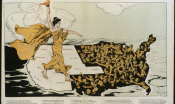lesson
The Early Republic
In this lesson, students examine voting rights in the early years of the United States and the causes and effects of the first major expansion of voting rights, which took place in the late 1700s and first half of the 1800s. By the end of the lesson, students will be able to explain where various groups of Americans stood regarding the right to vote before the Civil War, and will hypothesize about what they expect happened next.
October 21, 2011
